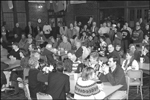 |
| Wartburg students at mealtime. |
There are some theological schools where, even twenty-five years ago, one would not have been surprised to see students from a variety of countries. University-related schools, big-city schools, schools like the now-defunct Maryknoll with a missions background—these are easy to associate with connections to the rest of the world. Most people, however, probably do not instinctively link the phrases “Wartburg Theological Seminary, Dubuque, Iowa” and “international students.” They should.
For the past two and a half decades, the school has been committed to drawing 10 percent of its student body from countries other than the United States. And it has met that goal, for the most part, through a series of partnerships with church bodies in a variety of places, a connection with the Division for Global Missions of the Evangelical Lutheran Church in America, and an array of congregations and individuals who are happy to contribute to the education of leaders for the global church once they have faces to go with the concept.
Much of the credit for the school’s commitment goes to William Weiblen, president of the seminary from 1971 to 1985. He modestly claimed that the commitment was a natural outgrowth of the presence of international students. When asked how many internationals were on Wartburg’s campus during his student days, however, he slowly replied, “Well, I think there may have been one German fellow.”
Like many men of his generation, Weiblen’s view of the world was expanded by military service—he spent a year in Korea. The time he spent at Harvard introduced him to the contributions of students from other cultures. By the time he became president of Wartburg, he had become familiar with the church in Namibia, and he shared his commitment to ending apartheid with the seminary community. When the numbers of international students began to grow, he said, “We found the money one case at a time.”
This year, students came to Wartburg from fifteen countries, including eight African countries. Some are in the master of divinity program, some in the master of sacred theology, and eight are part of the school’s new M.A. in theology, development, and evangelism. Each has been sent by a home church to gain particular skills. Half of each student’s support is provided by the ELCA through its international students’ scholarship program.
The rest of the money—which according to the student services office, averages $18,050 per year for a single international student—comes through the school by way of congregations and individuals who have caught the vision. The means by which they catch the vision, of course, is the presence of international students in their congregations. “We’ve learned over the years to get the balance right between what students can learn in congregations and what congregations learn from students,” said David Solberg, Wartburg’s director of development.
So, for example, the churches of the East-Central Synod of Wisconsin had a regular practice for a decade or so of inviting an international seminarian to spend the January term visiting four congregations for one week each. The visit culminated with preaching the Sunday sermon. “We started with Namibian students in the days when that country was struggling for independence,” said the Reverend Tom McFarland, then chair of the committee that arranged the visits, “and it really brought justice issues home to congregations.” Years later, some of those congregations still contribute to the international student fund at Wartburg.